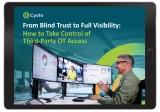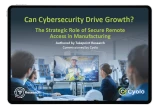Table of Contents
- Why Your Enterprise IdP Stalls on the Factory Floor
- 1. Cloud Dependency Collides With OT Network Reality
- 2. Legacy Devices and Protocol Mismatches
- 3. Multiple Directories and Policy Drift Across Sites
- 4. Vendor Access Moves Faster Than Your IdP Can Handle
- 5. MFA Breaks in Low-Connectivity or Restricted OT Environments
- How to Extend Identity into the OT Environment Without Replacing Tools or Disrupting Operations
Your identity provider (IdP) is a critical part of your enterprise security stack. It works smoothly across IT applications, reduces password fatigue through single sign-on (SSO), and delivers a simple, consistent authentication experience for users.
But the moment you try to extend that same identity strategy into your OT environment, it’s likely that problems start popping up. This is because legacy systems, isolated networks, safety constraints, and third-party vendor workflows all collide with the basic assumptions IdPs were designed around. In OT, these identity gaps can slow down maintenance, block vendor access, disrupt troubleshooting, and even introduce safety risks.
If you’ve struggled to make your IdP work across plants or critical infrastructure, you’re not imagining it and you’re definitely not alone. In this blog, we’ll look at five of the most common ways IdPs fall short in OT environments, why these failures happen, and how to fix them — without replacing your existing identity provider.
Why Your Enterprise IdP Stalls on the Factory Floor
1. Cloud Dependency Collides With OT Network Reality
Most IdPs presume a world where connectivity is constant and reliable. This requirement generally fits IT environments but breaks down inside OT networks.
Industrial environments often operate across segmented, latency-sensitive, or intermittently connected networks, and some systems are fully air-gapped or isolated to protect safety and uptime. Even a brief loss of connectivity or an overzealous firewall rule can break the communication path your IdP needs for login, token refresh, or multi-factor authentication (MFA) challenges.
When your IdP relies on cloud availability, several OT-specific issues can arise:
Authentication can fail mid-session, disrupting maintenance tasks, calibrations, or remote troubleshooting.
Technicians can get locked out during critical work because the site can’t reach the cloud service at that moment.
Policies drift over time when cached credentials or offline workarounds are used as “temporary fixes.”
Local operations may continue without centralized oversight, creating audit gaps and inconsistent enforcement across sites.
What starts as a connectivity problem quickly becomes a security and operational problem. In OT, where every minute of downtime has real-world consequences, depending on always-on cloud access for identity simply doesn’t work.
2. Legacy Devices and Protocol Mismatches
OT environments commonly rely on systems that predate modern identity standards – and maybe even the internet itself. Many PLCs, HMIs, SCADA servers, historians, engineering workstations, and DCS consoles were built for reliability and uptime, not federated identity or cloud authentication.
These assets typically can’t:
Run SAML or OIDC
Join a domain
Execute identity agents
Handle token-based authentication
Integrate with enterprise IdPs
Instead, access usually happens through RDP, VNC, SSH, proprietary engineering tools, or serial tunneling, none of which your IdP can natively control.
In order to get their work done and keep operations moving, teams compensate with:
Shared local accounts
Static passwords
Jump servers with excessive privileges
Privileged logins that can’t be tied to a specific individual (e.g. Operator 1)
Rather than a unified identity model, you get fragmented authentication paths and uneven enforcement, especially in environments with mixed-generation equipment. The ultimate result is visibility and accountability gaps that may actually increase your risk exposure.
3. Multiple Directories and Policy Drift Across Sites
Most industrial organizations operate with a patchwork of identity sources accumulated over many years (and maybe a couple of acquisitions). It’s not unusual to see a combination of:
Multiple corporate IdPs
Separate Active Directory forests per site or region
Contractor and vendor identity systems
Business-unit-specific user stores
Local device-level accounts
Each system handles roles, permissions, and MFA differently. Over time, this can cause:
Duplicate or stale accounts
Conflicting permissions between plants
Policy drift across sites
Gaps in visibility into who has access to what
Audit reports that never fully reflect reality
In safety-critical OT environments, this inconsistent identity governance becomes a significant operational and security risk.
4. Vendor Access Moves Faster Than Your IdP Can Handle
Industrial enterprises, from manufacturers to energy providers, depend heavily on third-party support. Vendor turnover is continuous, and maintenance windows to keep critical systems running are tight.
Traditional IdPs struggle to keep pace with rapid onboarding and offboarding. Typical JML (joiner–mover–leaver) processes are slow, controlled centrally by IT, and not optimized for temporary contractors.
But when there’s a problem on the production line, OT teams need to get technicians connected to critical assets in minutes, not hours or days. When the approved IdP can’t provide this quick turnaround, teams will circumvent it with:
Shared VPN accounts
Local accounts created “just for today”
Temporary admin rights that never get revoked
Generic vendor profiles with overly broad access
These well-intentioned shortcuts can eventually lead to identity sprawl and compliance violations.
5. MFA Breaks in Low-Connectivity or Restricted OT Environments
MFA is a cornerstone of modern identity security. Unfortunately, traditional MFA methods just don’t work in many OT settings. Most MFA workflows rely on smartphones, stable internet, and cloud-connected validation services – but these are not always available in OT settings.
Common OT limitations include:
Mobile phones prohibited for safety reasons or simply inaccessible
Unreliable or limited connectivity on the plant floor
Air-gapped or network segments
External vendors without corporate-issued devices
Push notifications and SMS codes that never arrive
When MFA can’t function, teams fall back to insecure access methods:
Single-factor VPN access
Local passwords
“Temporary” exceptions
Shared accounts across shifts or contractors
IdPs assume connectivity that OT environments often cannot consistently provide, creating a a potentially dangerous gap between policy intent and operational reality.
How to Extend Identity into the OT Environment Without Replacing Tools or Disrupting Operations
Identity should be your strongest control, not your weakest link.
But if your IdP can’t keep up with how technicians, engineers, and vendors really access OT systems, the solution isn’t to rip it out. It’s to bring identity to where operations actually happen – inside plants, substations, control rooms, pumping stations, and everywhere in between.
The Cyolo PRO (Privileged Remote Operations) access solution makes this possible in a way that aligns with real industrial work.
Cyolo PRO brings identity, zero trust, and least-privilege access directly into OT networks, without relying on cloud connectivity or requiring infrastructure redesigns. Its decentralized architecture reflects the realities of manufacturing, energy, transportation, and other critical sectors, where connectivity can be intermittent, legacy devices cannot run agents, and safety always comes first.
With Cyolo, you can:
Work with any IdP – or multiple IdPs. Ideal for organizations with site-level Active Directory domains or acquisitions. A chemical manufacturer might keep its legacy AD at each plant while giving technicians a single, modern identity-based login.
Extend modern identity into OT protocols. Whether a wind turbine engineer needs secure RDP into a SCADA workstation or a pipeline technician needs SSH access to a remote pump controller, Cyolomaps enterprise identity to the tools OT teams actually use – RDP, SSH, VNC, engineering software, and more.
Support MFA everywhere – even in low-connectivity environments. With Cyolo PRO, operators at a refinery who can’t carry smartphones due to safety rules and field crews working at a substation with limited reception can still authenticate with MFA designed for restricted or offline conditions.
Maintain complete identity-level audit trails. Instead of shared maintenance accounts on a water treatment plant’s HMI or DCS server, every action is tied to an individual identity – making compliance reporting and incident reconstruction substantially easier.
Onboard and offboard vendors instantly. When a packaging-line vendor needs immediate access for a breakdown, plant teams can grant – and then revoke – session-level access in minutes, while continuing to adhere to corporate security policies.
Cyolo PRO turns identity from a roadblock into a reliable operational control, giving OT, IT, and security teams a unified way to authenticate users without disrupting operations or forcing OT environments to behave like IT networks.
Learn more about Cyolo PRO, the secure remote privileged access solution for OT:

Shir Basok
Author
Shir Basok is a Product Marketing Manager at Cyolo, where she transforms deep technical expertise in secure remote access and OT security into stories that drive awareness and action. She’s passionate about simplifying cybersecurity and helping organizations protect what matters most — their operations.

Subscribe to Our Newsletter







